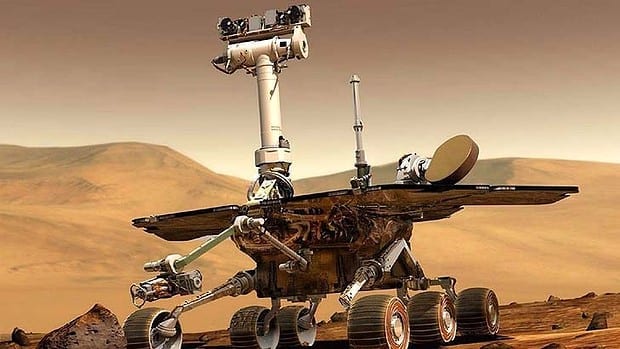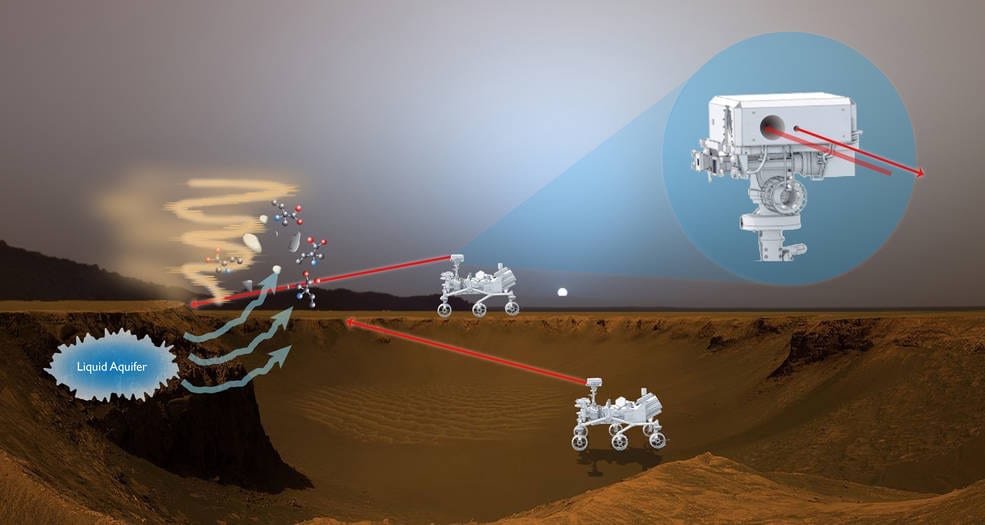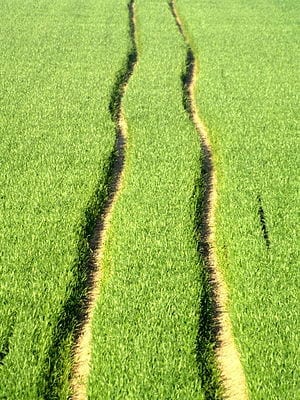
It contains evidence that potentially life-supporting water once flowed in abundance, leaving clay minerals behind.
Scientists on Friday called NASA’s Opportunity rover gimpy and arthritic, but hailed its new discoveries about early water on Mars made almost 10 years after it was launched toward the Red Planet.
The unmanned solar-powered vehicle has just analysed what may be its oldest rock ever, known as Esperance 6. It contains evidence that potentially life-supporting water once flowed in abundance, leaving clay minerals behind.
“This is powerful evidence that water interacted with this rock and changed its chemistry, changed its mineralogy in a dramatic way,” said principal investigator Steve Squyres of Cornell University.
He described the research as “some of the most important” of the decade-long mission because it showcases a very different chemistry than most of the previous discoveries about water on Mars, which is now quite dry.
Scientists believe that a lot of water once flowed through these rocks through some sort of fracture, leaving an unusually high concentration of clay.
The analysis reveals traces of a likely drinkable type of water that dates to the first billion years of Martian history, when clay rocks were forming under a more neutral pH, before conditions became more harsh and water more acidic, Squyres said.
The rover’s rock abrasion tool, alpha particle X-ray spectrometer and microscopic imager provided the details to Earth-based scientists, who can learn about the Red Planet’s history without bringing its rocks to Earth.
Opportunity and its twin Rover Spirit launched in 2003 and landed in January 2004 for what was initially meant to be a three-month exploration. Both discovered evidence of wet environments on ancient Mars.
“What Opportunity has mostly discovered evidence for was sulfuric acid,” Squyres told reporters, outlining the major difference detected in the Esperance rock’s formation. “This is water you could drink,” he said.
The oldest rocks, like Esperance, have a neutral pH, signaling that early Martian water was “probably much more favourable in its chemistry, in its pH, in its level of acidity for things like prebiotic chemistry, the kind of chemistry that could lead to the origin of life.”
Squyres said the six-wheeled Opportunity rover “has kind of a gimpy shoulder” and that analysis of Esperance took seven tries over many weeks as the rover endured a dust storm, a lumpy terrain and a period when Mars went behind the Sun and out of contact with Earth.
Now, Opportunity is slowly making its way — about 50 meters per day) — toward an area 1.5 kilometers away known as Solander Point that contains 10 times as many geological layers for study as the area where Esperance was found.
It hopes to arrive by August 1.
The Latest Bing News on:
Mars rover
- Ingenuity Mars Helicopter down but definitely not outon April 26, 2024 at 1:28 pm
NASA's Ingenuity Mars Helicopter, which vastly exceeded all expectations, has relayed its final transmission back to Earth. Now it's onto a new phase of its mission where it will continue to collect data for future explorers to retrieve.
- It's Been 20 Years Since NASA Drew A Penis On Marson April 26, 2024 at 8:02 am
NASA scientists, according to Futurism, claim this is a “standard rover turning maneuver” and have done similar drawings with the tracks of the earlier Opportunity and later Curiosity rovers as well. So Mars actually has three dicks! It’s a regular sausage fest on the fourth planet from the sun, eh?
- Earth's Most Barren Spot Found Bursting With Microbial Activity, Boosting Search for Life on Marson April 26, 2024 at 7:13 am
Underneath the parched sands is a massive, diverse group of bacteria and a previously undetected biosphere, according to a new study.
- A NASA Mars rover is in a great place to search for signs of lifeon April 25, 2024 at 5:37 am
Unlike its predecessor Curiosity, NASA’s Perseverance rover is explicitly intended to “search for potential evidence of past life,” according to the official mission objectives.
The Latest Google Headlines on:
Mars rover
[google_news title=”” keyword=”Mars rover” num_posts=”10″ blurb_length=”0″ show_thumb=”left”]
The Latest Bing News on:
Mars exploration
- China sets 2030 target to overtake US in Mars sample mission, space official sayson April 27, 2024 at 8:22 am
According to the chief architect of the Chinese Lunar Exploration Programme, Wu Weiren, the country plans to launch the Tianwen-3 spacecraft around 2030 to implement its Mars sample return mission.
- OU space researchers awarded £1.3M grant to develop world-leading imaging instrument for the Moon and Marson April 26, 2024 at 6:33 am
’This significant funding we have been awarded conveys the reputation of the OU and the UK as a world-leader in cutting-edge detector technology and space research. This project will help deliver a ...
- Curiosity rover may be 'burping' methane out of Mars' subsurfaceon April 25, 2024 at 1:00 pm
Salt might play a key role in the mysterious behavior of methane seeps on Mars. Since 2012, NASA's Curiosity rover has repeatedly detected methane on Mars, specifically near its landing site inside ...
- NASA planning September launch of Mars smallsat mission on first New Glennon April 25, 2024 at 4:35 am
A NASA Mars smallsat mission is slated to launch in late September on the first flight of Blue Origin’s New Glenn rocket, if the vehicle is ready in time.
- NASA Is Locking People Up and Tells Them They're Astronauts Heading for Marson April 22, 2024 at 4:21 am
These efforts include isolating a bunch of volunteers inside a simulated Mars habitat located here on Earth ... there is a facility called Human Exploration Research Analog. That's HERA, for short, ...
- This Massive Space Balloon Could Also Be Our First Home on Marson April 22, 2024 at 2:02 am
A space startup called Max Space is working on a family of space habitats that may provide ten times the pressurized volume of the ISS ...
- Ingenuity's travels: New NASA video tracks Mars helicopter's 72 flightson April 19, 2024 at 11:01 am
Jam packed issues filled with the latest cutting-edge research, technology and theories delivered in an entertaining and visually stunning way, aiming to educate and inspire readers of all ages ...
- Final communications sent to the beloved Ingenuity Mars helicopteron April 17, 2024 at 3:17 pm
NASA's hugely successful Mars helicopter Ingenuity will continue saving data in case future explorers should come its way again.
- NASA’s no to Marson April 17, 2024 at 8:01 am
Supporting Mars Sample Return is of utmost importance for continuing American leadership in space, despite recent NASA statements.
- Humans to Mars: What’s the holdup? – part IIon April 17, 2024 at 2:26 am
By the end of the last decade, NASA had a promising plan in motion. Yet, challenges emerged with a new administration and ongoing budget worries.
The Latest Google Headlines on:
Mars exploration
[google_news title=”” keyword=”Mars exploration” num_posts=”10″ blurb_length=”0″ show_thumb=”left”]










